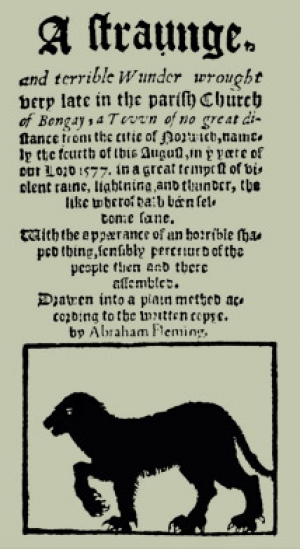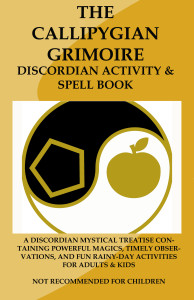Canines have long been associated with death. In Egyptian mythology, the jackal-headed god Anubis guided the dead through the underworld. Greek mythology had Cerberus, the multi-headed guardian of Hades’ realm. In Great Britain, the most famous hell hound is the Black Dog, also called Black Shuck, Padfoot, Barghest, and a host of other names. In addition to the numerous legends of the Black Dog, it seems likely that the creature was the inspiration for Sir Arthur Conan Doyle’s The Hound of the Baskervilles.
 The exact details of Black Dog sightings vary, but there are a few common threads. The Black Dog is almost universally described as unnaturally large, usually the size of a calf. His coat, often described as shaggy (which may be the origin of the name “Shuck”), is, as the name implies, of a dark, ominous hue. Black Shuck is often said to have flaming red eyes. Typically, the Black Dog is encountered by a solitary traveler, usually at night in a rural area. While some say that the Black Dog moves with an eerie silence, in other tales only the beast’s unusual size (and glowing red eyes) give him away as anything other than an ordinary pooch. The creature’s supernatural nature is only revealed when it suddenly disappears, sometimes sinking into the ground or disappearing in an eerie flash of light.
The exact details of Black Dog sightings vary, but there are a few common threads. The Black Dog is almost universally described as unnaturally large, usually the size of a calf. His coat, often described as shaggy (which may be the origin of the name “Shuck”), is, as the name implies, of a dark, ominous hue. Black Shuck is often said to have flaming red eyes. Typically, the Black Dog is encountered by a solitary traveler, usually at night in a rural area. While some say that the Black Dog moves with an eerie silence, in other tales only the beast’s unusual size (and glowing red eyes) give him away as anything other than an ordinary pooch. The creature’s supernatural nature is only revealed when it suddenly disappears, sometimes sinking into the ground or disappearing in an eerie flash of light.
Black Dogs are often associated with a particular region, with graveyards, cemeteries, and other magically-charged areas being most popular. While sometimes content to merely terrify their victims, more often they signal bad luck, often death of the person encountering them or a close relative. Like the banshee of Irish folklore, Black Dogs are sometimes associated with a certain family, and appear when a member is about to die.
The most famous encounter with Black Shuck is recorded in Reverend Abraham Fleming’s 16th Century pamphlet, A Straunge and Terrible Wunder. According to Fleming, in August of 1577 Black Shuck appeared at St. Mary’s Church in Bungay, where he killed two people and disappeared. Moments later, the dog showed up Holy Trinity Church in Blythburgh, seven miles away. Here he killed two men and a boy, burned the hand of another victim, and left claw marks (which can still be seen today) on the church’s door. Fleming’s tale departs from the usual Black Dog encounter by turning the creature into an actual bringer of death, rather than a mere death omen. In her article “A Straunge and Terrible Wunder,” (Fortean Times #195, May 2005) Clare Stubbs explores possible explanations for this change, including Black Shuck as a metaphor for Danish invaders and the possibility that Fleming hallucinated the event as a result of Ergot poisoning.
While an encounter with a Black Dog is rarely a pleasant experience, it does not always mean death. According to some stories, death only comes to those who touch or make eye contact with the creature. Still, if you find yourself alone at night, it’s probably wise to avoid straying too far from the beaten path.



















































